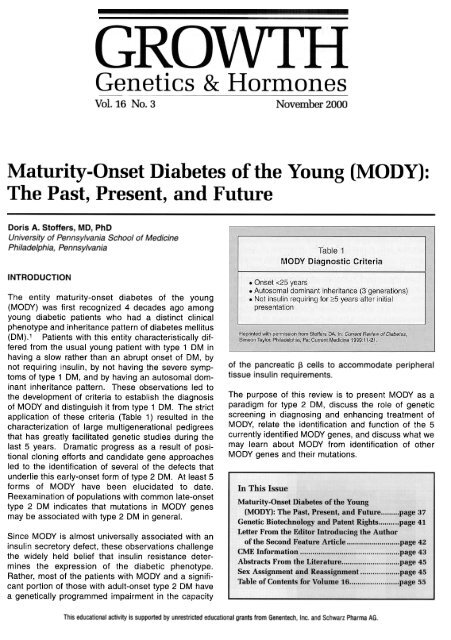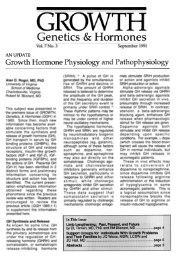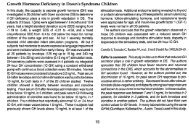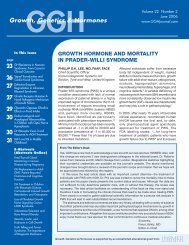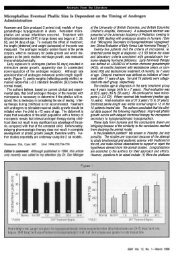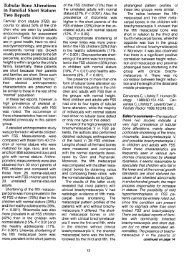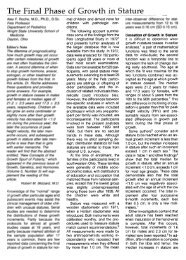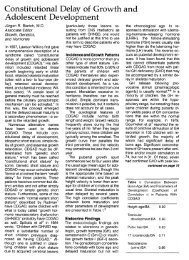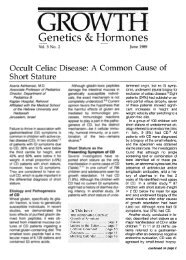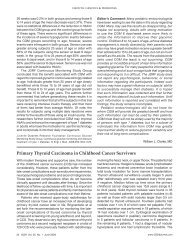maturity-onset diabetes of the young (mody) - GGH Journal
maturity-onset diabetes of the young (mody) - GGH Journal
maturity-onset diabetes of the young (mody) - GGH Journal
You also want an ePaper? Increase the reach of your titles
YUMPU automatically turns print PDFs into web optimized ePapers that Google loves.
Vol. 16 No.3 November 2000<br />
Doris A. St<strong>of</strong>fers, MD, PhD<br />
University <strong>of</strong> Pennsylvania School <strong>of</strong> Medicine<br />
Philadelphia, Pennsylvania<br />
INTRODUCTION<br />
The entity <strong>maturity</strong>-<strong>onset</strong> <strong>diabetes</strong> <strong>of</strong> <strong>the</strong> <strong>young</strong><br />
(MODY) was first recognized 4 decades ago among<br />
<strong>young</strong> diabetic patients who had a distinct clinical<br />
phenotype and inheritance pattern <strong>of</strong> <strong>diabetes</strong> mellitus<br />
(DM).1 Patients with this entity characteristically differed<br />
from <strong>the</strong> usual <strong>young</strong> patient with type 1 DM in<br />
having a slow ra<strong>the</strong>r than an abrupt <strong>onset</strong> <strong>of</strong> DM, by<br />
not requiring insulin, by not having <strong>the</strong> severe symptoms<br />
<strong>of</strong> type 1 DM, and by having an autosomal dominant<br />
inheritance pattern. These observations led to<br />
<strong>the</strong> development <strong>of</strong> criteria to establish <strong>the</strong> diagnosis<br />
<strong>of</strong> MODY and distinguish it from type 1 DM. The strict<br />
application <strong>of</strong> <strong>the</strong>se criteria (Table 1) resulted in <strong>the</strong><br />
characterization <strong>of</strong> large multigenerational pedigrees<br />
that has greatly facilitated genetic studies during <strong>the</strong><br />
last 5 years. Dramatic progress as a result <strong>of</strong> positional<br />
cloning efforts and candidate gene approaches<br />
led to <strong>the</strong> identification <strong>of</strong> several <strong>of</strong> <strong>the</strong> defects that<br />
underlie this early-<strong>onset</strong> form <strong>of</strong> type 2 DM. At least 5<br />
forms <strong>of</strong> MODY have been elucidated to date.<br />
Reexamination <strong>of</strong> populations with common late-<strong>onset</strong><br />
type 2 DM indicates that mutations in MODY genes<br />
may be associated with type 2 DM in general.<br />
<strong>of</strong> <strong>the</strong> pancreatic ~ cells to accommodate peripheral<br />
tissue insulin requirements.<br />
The purpose <strong>of</strong> this review is to present MODY as a<br />
paradigm for type 2 DM, discuss <strong>the</strong> role <strong>of</strong> genetic<br />
screening in diagnosing and enhancing treatment <strong>of</strong><br />
MODY, relate <strong>the</strong> identification and function <strong>of</strong> <strong>the</strong> 5<br />
currently identified MODY genes, and discuss what we<br />
may learn about MODY from identification <strong>of</strong> o<strong>the</strong>r<br />
MODY genes and <strong>the</strong>ir mutations.<br />
Since MOOY is almost universally associated with an<br />
insulin secretory defect, <strong>the</strong>se observations challenge<br />
<strong>the</strong> widely held belief that insulin resistance determines<br />
<strong>the</strong> expression <strong>of</strong> <strong>the</strong> diabetic phenotype.<br />
Ra<strong>the</strong>r, most <strong>of</strong> <strong>the</strong> patients with MOOY and a significant<br />
portion <strong>of</strong> those with adult-<strong>onset</strong> type 2 OM have<br />
a genetically programmed impairment in <strong>the</strong> capacity<br />
This educational activity is supported by unrestricted educational grants from Genentech, Inc. and Schwarz Pharma AG.
MODY As a Paradigm<br />
for Type 2 DM<br />
The advances in our understanding <strong>of</strong> MOOY are relevant<br />
to our understanding <strong>of</strong> <strong>the</strong> genetics and pathophysiology<br />
<strong>of</strong> type 2 OM in general. This is exemplified<br />
by <strong>the</strong> identification <strong>of</strong> mutations in MOOY genes in subjects<br />
with late-<strong>onset</strong> type 2 OM.2-4 Fur<strong>the</strong>rmore, <strong>the</strong>re<br />
is <strong>of</strong>ten variation within MOOY pedigrees with regard to<br />
<strong>the</strong> age <strong>of</strong> <strong>onset</strong> such that multiple affected members in<br />
some MOOY pedigrees may have <strong>onset</strong> <strong>of</strong> disease after<br />
age 40. While <strong>the</strong> later age at diagnosis sometimes<br />
reflects a delay in ascertainment because <strong>of</strong> a mild phenotype,<br />
it also suggests that o<strong>the</strong>r factors, both genetic<br />
and environmental, may modify <strong>the</strong> expression <strong>of</strong> <strong>diabetes</strong><br />
due to specific mutations in MOOY gene loci. This<br />
leads to <strong>the</strong> consideration that mild mutations or polymorphisms<br />
in MOOY genes may result in only a slight<br />
impairment <strong>of</strong> protein function and, <strong>the</strong>refore, may contribute<br />
to <strong>the</strong> expression <strong>of</strong> <strong>diabetes</strong> in a polygenic con-text.<br />
A common polymorphism at codon 98 <strong>of</strong> <strong>the</strong> HNF-1 a<br />
gene (MODY3), which is not linked to OM in a Mendelian<br />
fashion, is never<strong>the</strong>less associated with reduced serum<br />
C-peptide and a reduced insulin response to glucose<br />
challenge. The prevalent yet incompletely penetrant<br />
D76N mutation in IPF-1 (MODY4) is associated with<br />
marked impairment in insulin secretion even in normal homeostasis, with some subjects remaining well controlled<br />
on diet or sulfonylureas and o<strong>the</strong>rs progressing<br />
glucose-tolerant carriers <strong>of</strong> <strong>the</strong> mutation. Oigenic inheritance<br />
in a family with late-<strong>onset</strong> type 2 OM has been<br />
documented in which <strong>the</strong> severity <strong>of</strong> <strong>the</strong> diabetic phenotype<br />
appears to relate to <strong>the</strong> cosegregation <strong>of</strong> 2 distinct<br />
mutations in 2 different pancreatic transcription factor<br />
genes, IPF-1 (MODY4) and 181, a transcriptional regulator<br />
<strong>of</strong> GLUT2 gene expression. Mutations that impair<br />
[3-cell compensatory mechanisms also could act in<br />
concert with genetic defects in insulin action to cause<br />
<strong>diabetes</strong>.<br />
POSSIBLE<br />
ROLE OF GENETIC SCREENING<br />
to insulin <strong>the</strong>rapy. The incidence <strong>of</strong> complications for<br />
MOOY1 and MOOY3 resemble those <strong>of</strong> late-<strong>onset</strong> type<br />
2 OM. MOOY5 appears to be particularly associated<br />
with renal complications and cysts. Genetic screening<br />
can be an important predictor <strong>of</strong> both quality and quantity<br />
<strong>of</strong> life (Table 2) and <strong>the</strong> need for more rigid <strong>the</strong>rapy<br />
than in MOOY2 patients. Therefore, childhood <strong>diabetes</strong><br />
is a specific instance in which genetic screening can be<br />
helpful. Several studies have now attributed previously<br />
diagnosed type 1 OM (usually autoimmune) to mutations<br />
in HNF-1a (MODY3).6,7 These subjects were not<br />
characterized by <strong>the</strong> expression <strong>of</strong> autoimmune markers<br />
but were given <strong>the</strong> diagnosis <strong>of</strong> type 1 OM because<br />
<strong>of</strong> <strong>the</strong> early age <strong>of</strong> <strong>onset</strong>. This is significant, as <strong>the</strong><br />
future clinical course is distinctly different for type 1 OM<br />
Genetic screening for specific mutations in <strong>diabetes</strong><br />
genes may <strong>of</strong>fer several <strong>the</strong>rapeutic advantages.5<br />
Determination <strong>of</strong> <strong>the</strong> genetic mutations in cases <strong>of</strong><br />
MODY may assist in <strong>the</strong> determination <strong>of</strong> prognosis and type 2 MOOY. Screening and diagnosis <strong>of</strong> MOOY<br />
(Table 2), choice <strong>of</strong> optimal <strong>the</strong>rapy, and early implementation<br />
<strong>of</strong> <strong>the</strong> appropriate lifestyle to reduce compli-cations. <strong>the</strong>rapy, especially involving insulin. Routine screening<br />
provides a more measured approach in terms <strong>of</strong> clinical<br />
Although all forms <strong>of</strong> MODY identified so far in <strong>the</strong> clinical setting, however, will require ongoing and<br />
are characterized by an insulin secretory defect, <strong>the</strong> future technological advances in mutation detection<br />
precise nature <strong>of</strong> <strong>the</strong> defect and <strong>the</strong> clinical course vary before it can become practical and economically<br />
according to <strong>the</strong> genetic defect(s). For example, feasible.<br />
MODY2 is characterized by mild fasting hyperglycemia<br />
that is <strong>of</strong>ten already evident in early childhood. FUNCTION AND IDENTIFICATION OF<br />
However, less than half <strong>of</strong> <strong>the</strong> patients will progress to MODY GENES<br />
overt <strong>diabetes</strong>, few will develop complications, and most<br />
will not require medical intervention, except duringpregnancy. A brief review <strong>of</strong> glucose metabolism, glycolysis, and<br />
These characteristics allow a clinical insulin secretion provides a foundation for comprehending<br />
<strong>the</strong> function and identification <strong>of</strong> MODY genes.2,3<br />
approach <strong>of</strong> limited monitoring. As ano<strong>the</strong>r example,<br />
<strong>the</strong> clinical phenotypes <strong>of</strong> MODY1 and MODY3 are both The islet ~ cell is uniquely equipped to sense blood glucose<br />
concentrations and to secrete insulin in a characterized by progressive deterioration <strong>of</strong> glucose<br />
precise<br />
<strong>GGH</strong>Vol. 16, No.3-November 2000<br />
38
fashion to maintain glucose in a narrow physiologic<br />
range.8 In <strong>the</strong> pancreatic f3 cells and in hepatocytes,<br />
uptake <strong>of</strong> glucose is mediated by <strong>the</strong> high Km glucose<br />
transporter GLUT2. Glucose metabolism must be<br />
initiated to stimulate insulin secretion. Glycolysis is <strong>the</strong><br />
first step in glucose metabolism and occurs in both <strong>the</strong><br />
pancreas and liver. Glucokinase, <strong>the</strong> low Km rate-limiting<br />
hexokinase that phosphorylates glucose to glucose-6-<br />
phosphate, is <strong>the</strong> catalyst. Glycolysis in <strong>the</strong> f3 cell results<br />
in <strong>the</strong> generation <strong>of</strong> adenosine triphosphate (ATP),<br />
which causes <strong>the</strong> closure <strong>of</strong> ATP-sensitive potassium<br />
channels. This depolarizes <strong>the</strong> f3 cell, causing calcium<br />
channels to open. Calcium <strong>the</strong>n flows into <strong>the</strong> cells, triggering<br />
secretion <strong>of</strong> insulin.<br />
The first MOOY locus to be identified (MODY2) was<br />
found to encode glucokinase, <strong>the</strong> key regulatory<br />
enzyme in glucose metabolism (Table 3).9,10<br />
Interestingly, mutations in <strong>the</strong> glucokinase (MODY2)<br />
gene not only produce OM but also can produce<br />
reduced birth weight in <strong>the</strong> fetus.11 Most mutations in<br />
<strong>the</strong> glucokinase gene decrease insulin secretion and<br />
appear to cause <strong>diabetes</strong> through a gene-dosage effect.<br />
Interestingly, <strong>the</strong>re is at least 1 activating mutation<br />
that causes hyperinsulinemia and hypoglycemia,12<br />
fur<strong>the</strong>r establishing <strong>the</strong> critical function <strong>of</strong> glucokinase<br />
in sensing blood glucose levels and in maintaining a<br />
normal glucose-induced secretory insulin response. This<br />
may reflect decreased fetal insulin, which functions as<br />
a growth factor in utero. Glucokinase mutations in <strong>the</strong><br />
fetus may impair fetal insulin secretion in response to<br />
normal maternal glucose levels. If, however, <strong>the</strong> mo<strong>the</strong>r<br />
also is heterozygous for <strong>the</strong> glucokinase mutation,<br />
<strong>the</strong> higher maternal glucose levels will provoke greater<br />
fetal insulin secretion, leading to MOOY2 infants with<br />
normal birth weights. O<strong>the</strong>r characteristic features <strong>of</strong><br />
MOOY2 include <strong>the</strong> mildness <strong>of</strong> <strong>the</strong> disease compared<br />
with MOOY1, MOOY3, and MOOY5; <strong>the</strong> multiple variants<br />
<strong>of</strong> mutations found (-50); and <strong>the</strong> rarity <strong>of</strong> compli-cations.<br />
metabolism, but <strong>of</strong>ten are equally important in differentiation<br />
and development.<br />
The most extensive and well-characterized MODY<br />
pedigree is <strong>the</strong> RW pedigree, which has been followed<br />
prospectively since 1958; it now consists <strong>of</strong> 455 members<br />
in 7 generations and includes 74 diabetics.14<br />
Diabetes in <strong>the</strong> RW pedigree was linked to a DNA<br />
polymorphism on chromosome 20 in 1991.15 Once<br />
HNF-1a was determined to be <strong>the</strong> MODY3 gene, a<br />
scan <strong>of</strong> known genes in <strong>the</strong> MODY1 interval raised<br />
HNF-4a as an intriguing candidate, since HNF-4a is a<br />
known upstream regulator <strong>of</strong> HNF-1a. This hypo<strong>the</strong>sis<br />
was confirmed with <strong>the</strong> identification <strong>of</strong> <strong>the</strong> Q268X<br />
nonsense mutation in <strong>the</strong> RW pedigree.2 The relationship<br />
between HNF-1a and HNF-4a in <strong>diabetes</strong> is<br />
fur<strong>the</strong>r underscored by <strong>the</strong> identification <strong>of</strong> a MODY<br />
mutation in <strong>the</strong> HNF-4a promoter in an Italian MODY<br />
pedigree.16<br />
HNF-4a encodes an orphan member <strong>of</strong> <strong>the</strong> nuclear<br />
hormone receptor superfamily that regulates gene<br />
expression required for glucose transport and metabolism.<br />
The Q268X mutation results in <strong>the</strong> syn<strong>the</strong>sis<br />
<strong>of</strong> a truncated protein that does not activate gene<br />
transcription.17 Mutations in HNF-4a remain a relatively<br />
rare cause <strong>of</strong> <strong>diabetes</strong> as only 6 mutations have<br />
been reported. Interestingly, 1 <strong>of</strong> <strong>the</strong>se mutations<br />
(V3931) was identified in a family with late-<strong>onset</strong> type<br />
2 OM, demonstrating <strong>the</strong> overlap that different mutations<br />
provide for MOOY and <strong>the</strong> adult phenotype <strong>of</strong><br />
type 2 OM.<br />
All <strong>of</strong> <strong>the</strong> MODY genes1,3,4 except that for MODY2<br />
encode transcription factors localized to <strong>the</strong> pancreas<br />
and o<strong>the</strong>r tissues such as liver and kidney (Table 3).<br />
Two approaches, positional cloning and screening <strong>of</strong><br />
candidate genes, resulted in <strong>the</strong> identification <strong>of</strong><br />
specific transcription factor mutations. Positional<br />
cloning using <strong>the</strong> previously characterized large<br />
MODY pedigrees led to <strong>the</strong> identification <strong>of</strong> MODY1<br />
and MODY3 as <strong>the</strong> genes encoding hepatocyte<br />
nuclear factors HNF-4a and HNF-1a, respectively.<br />
The HNFs were originally discovered as a heterogeneous<br />
family <strong>of</strong> transcription factors that control liverspecific<br />
gene expression. Subsequently, HNFs were<br />
identified in o<strong>the</strong>r tissues, including pancreatic islets.13<br />
The HNFs form a network <strong>of</strong> cross-regulatory transcription<br />
factors that regulate expression <strong>of</strong> genes<br />
involved in a wide range <strong>of</strong> cellular processes in<br />
39 <strong>GGH</strong>Vol. 16, No.3-November 2000
The identity <strong>of</strong> <strong>the</strong> MODY3 locus also was determined<br />
by a positional cloning approach. In 1996, a cytosine<br />
insertion was identified in codon 291 <strong>of</strong> HNF-1a<br />
(P291fsdeIC). This segregated with OM in a MOOY3<br />
pedigree. This particular mutant <strong>of</strong> <strong>the</strong> HNF-1a gene<br />
is a frameshifted truncated protein that appears to<br />
function in a dominant negative manner.18 Mutations<br />
(57 to date) in MODY3 are highly prevalent, accounting<br />
for 64% <strong>of</strong> MOOY in <strong>the</strong> United Kingdom, 30% <strong>of</strong><br />
early-<strong>onset</strong> type 2 OM in Germany, and 15% to 20% <strong>of</strong><br />
MOOY in Japan. The P291fsdeiC mutation has<br />
appeared in at least 9 distinct haplotypes in Germany,<br />
Britain, <strong>the</strong> United States, Sweden, and Japan, implying<br />
<strong>the</strong> existence <strong>of</strong> a mutational hot spot. HNF-1a<br />
appears to regulate transcription <strong>of</strong> <strong>the</strong> insulin gene,<br />
<strong>the</strong> GLUT2 gene, and o<strong>the</strong>r genes encoding components<br />
<strong>of</strong> <strong>the</strong> r3-cell glycolytic pathway.<br />
The most recently described MOOY gene (MODY5)<br />
encodes HNF-1[3, ano<strong>the</strong>r member <strong>of</strong> <strong>the</strong> transcriptional<br />
regulatory network that includes HNF-1a and HNF-4a<br />
(Table 3). The HNF-1f3 gene was screened because it<br />
was known that HNF-1[3 can function as a heterodimerization<br />
partner with HNF-1a. A nonsense mutation in<br />
HNF-1f3, R177X, was identified in a small Japanese<br />
pedigree with early <strong>onset</strong> <strong>of</strong> OM at age 10 and 15, but<br />
one member developed OM later, at age 40.12 All had<br />
evidence <strong>of</strong> diabetic neuropathy. Subsequent screens<br />
have identified 2 additional mutations in families with<br />
early-<strong>onset</strong> OM and MOOY associated with renal failure<br />
and renal cysts, and ano<strong>the</strong>r mutation in late-<strong>onset</strong> type<br />
2 OM not associated with kidney disease.<br />
The identity <strong>of</strong> <strong>the</strong> MOOY 4 locus reflects <strong>the</strong> close<br />
relationship between pancreatic development and<br />
glucose homeostasis. Experimental gene inactivation<br />
in mice is uncovering a growing number <strong>of</strong> transcription<br />
factor genes whose normal expression is required<br />
for full development <strong>of</strong> <strong>the</strong> exocrine and endocrine<br />
pancreas (Table 4). These genes are being evaluated<br />
as candidate <strong>diabetes</strong> genes. The first positive example<br />
<strong>of</strong> this approach came from mice with homozygous<br />
disruption <strong>of</strong> <strong>the</strong> IPF-1 gene and resultant total<br />
pancreatic agenesis. IPF-1, a homeodomain transcription<br />
factor, is implicated in <strong>the</strong> transcriptional<br />
regulation <strong>of</strong> key ~-cell genes. In humans, <strong>the</strong> first<br />
MODY 4 family was discovered when a rare subject<br />
with pancreatic agenesis was found to be homozygous<br />
for an inactivating cytosine deletion mutation in<br />
<strong>the</strong> protein coding sequence <strong>of</strong> IPF-1 (Pro63fsdeIC).19<br />
Subsequently, <strong>the</strong> heterozygous mutant allele within<br />
both branches <strong>of</strong> <strong>the</strong> extended family <strong>of</strong> <strong>the</strong> proband<br />
was linked to MODY.8 Three members <strong>of</strong> this pedigree<br />
satisfy <strong>the</strong> strictest criteria for <strong>the</strong> diagnosis <strong>of</strong><br />
MODY, and 2 additional heterozygous subjects developed<br />
<strong>diabetes</strong> or glucose intolerance by 30 years <strong>of</strong><br />
age, thus establishing IPF-1 as <strong>the</strong> MODY 4 gene. To<br />
date, at least 7 additional heterozygous IPF-1 mutations<br />
have been discovered in approximately 5% to<br />
6% <strong>of</strong> familial late-<strong>onset</strong> type 2 OM patients in France<br />
and <strong>the</strong> United Kingdom and in a small number <strong>of</strong><br />
additional MOOY pedigrees.<br />
THE FUTURE<br />
While <strong>the</strong> recent advances in MODY genetics have<br />
been most exciting, <strong>the</strong>re remain additional MODY<br />
genes to be uncovered. In 2 MODY populations in<br />
France and England, in which screening for possible<br />
mutations in all 5 MODY genes has been undertaken,<br />
<strong>the</strong> genetic defect in 16% to 20% <strong>of</strong> MODY pedigrees<br />
remains a mystery. An ever-increasing number <strong>of</strong><br />
genes whose normal function is required for full development<br />
<strong>of</strong> <strong>the</strong> pancreas are being identified through<br />
analysis <strong>of</strong> <strong>the</strong> phenotypes <strong>of</strong> knockout mice (Table 4).20<br />
Some <strong>of</strong> <strong>the</strong>se genes probably will turn out to playa<br />
role in human type 2 DM. In support <strong>of</strong> this<br />
concept, several mutations in <strong>the</strong> human BETA2 gene<br />
were recently reported in familial late-<strong>onset</strong> type 2<br />
DM.21 O<strong>the</strong>r members <strong>of</strong> <strong>the</strong> transcriptional regulatory<br />
network <strong>of</strong> hepatocyte nuclear factors also are logical<br />
candidate <strong>diabetes</strong> genes to consider.<br />
Most MODY subjects exhibit decreased insulin secretion<br />
and lean body mass. However, <strong>the</strong>re are o<strong>the</strong>r<br />
MODY pedigrees (in which mutations in MODY1,<br />
<strong>GGH</strong>Vol. 16, No.3-November 2000<br />
40
MODY2, and MODY3 have been ruled out) that include<br />
diabetics with high circulating insulin levels and also a<br />
higher incidence <strong>of</strong> obesity than <strong>the</strong>ir unaffected relatives.22<br />
This form <strong>of</strong> MODY may be caused by mutations<br />
in a distinct class <strong>of</strong> genes whose function is not<br />
specifically involved in <strong>the</strong> regulation <strong>of</strong> f3-cell development<br />
and function.<br />
CONCLUSION<br />
MOOY is an autosomal dominant monogenic form <strong>of</strong><br />
type 2 OM that is characterized by a primary defect in<br />
insulin secretion. Four <strong>of</strong> <strong>the</strong> 5 MOOY genes discovered<br />
to date encode transcription factors that regulate [3-cell<br />
development and function. This observation has transformed<br />
our concept <strong>of</strong> <strong>diabetes</strong> into a disorder <strong>of</strong> <strong>the</strong><br />
[3 cell and has intensified research efforts aimed at<br />
improving <strong>the</strong> function and mass <strong>of</strong> insulin-producing<br />
[3 cells. Additional MOOY genes remain to be uncovered.<br />
The identification <strong>of</strong> mutations in MOOY genes in<br />
common late-<strong>onset</strong> type 2 OM indicates that MOOY is<br />
a useful paradigm for type 2 OM and that a genetically<br />
programmed impairment <strong>of</strong> <strong>the</strong> [3 cell may underlie<br />
a greater proportion <strong>of</strong> type 2 OM than previously<br />
suspected.<br />
REFERENCES<br />
1. Tattersall RE, Fajans SS. Diabetes 1975;24:44-53.<br />
2. St<strong>of</strong>fers DA. Current Review <strong>of</strong> Diabetes, Simeon Taylor.<br />
Philadelphia, Pa: Current Medicine 1999:11-21.<br />
3. Froguel P, Velho G. 1rends Endocrinol Metab 1999;10:142-146.<br />
4. Hattersley AT. Diabetes Med 1998;15:15-24.<br />
5. Matyka KA, et ai. Arch Dis Child 1998;78:552-554.<br />
6. Miura J, et ai. Diabetes Res Clin Pract 1997;38:139-141.<br />
7. Kawasaki E, et ai. J Clin Endocrinol Metab 2000;85:331-335.<br />
8. Matschinsky F. Diabetes 1996;45:223-241.<br />
9. Hattersley A, et al. Lancet 1992;339:1307-1310.<br />
10. Froguel Po et ai. Nature 1992;356:162-164.<br />
11. Hattersley AT, et ai. Nat Genet 1998;19:268-270.<br />
12. Horikawa Y, et ai. Nat Genet 1997;17:384-385.<br />
13. Miquerol L, et ai. J BioI Chem 1994;269:8944-8951.<br />
14. Fajans SS, et ai. Molecular Pathogenesis <strong>of</strong> MODYs, Karger.<br />
New York, NY: Frontiers in Diabetes. 1998;15:13.<br />
15. Bell GK, et ai. Proc Natl Acad Sci USA 1991;88:1484-1488.<br />
16. Gragnoli CT, et ai. Diabetes 1997;46:1648-1651.<br />
17. St<strong>of</strong>fel M, Duncan SA. Proc Natl Acad Sci USA 1997;94:13209-<br />
13214.<br />
18. Yamagata K, et ai. Diabetes 1998;47:1231-1236.<br />
19. St<strong>of</strong>fers DA, et al. Nat Genet 1997;15:106-110.<br />
20. Habener JF, St<strong>of</strong>fers DA. Proc Assoc Am Phys 1998;110:12-21.<br />
21. Maieci MT, et ai. Nat Genet 1999;23:323-328.<br />
22. Doria A, et ai. Diabetes Care 1999;22:253-261.<br />
William D. Noonan, MD, JD<br />
KIa rquis t Sparkman, LLP<br />
Portland, Oregon<br />
INTRODUCTION<br />
As <strong>the</strong> Human Genome Project (HGP) nears completion,<br />
scientists have engaged in a spirited discussion about<br />
ownership <strong>of</strong> genetic information and to what extent it<br />
should be patentable. Billions <strong>of</strong> dollars <strong>of</strong> private investment<br />
have contributed to cloning DNA sequences and<br />
protecting biotechnology resulting from this research,<br />
such as genetic tests. Many private companies have<br />
attempted to broadly protect intellectual property rights<br />
by patenting total or partial gene sequences and <strong>the</strong><br />
products <strong>the</strong>se sequences encode. Many <strong>of</strong> <strong>the</strong> patents<br />
obtained on gene sequences and related biotechnological<br />
inventions have been and remain controversial.<br />
Just as <strong>the</strong> HGP promises to transform <strong>the</strong> future<br />
practice <strong>of</strong> medicine, <strong>the</strong> associated legal developments<br />
signal a transformation in medical economics. In this article<br />
<strong>the</strong> historic perspective <strong>of</strong> this topic is succinctly presented,<br />
and <strong>the</strong> legal requirements for patentability are<br />
discussed. This article also reviews recent controversies<br />
about patenting genomic sequences, partial gene<br />
sequences, and genetic tests, and <strong>the</strong> patent rights <strong>of</strong> a<br />
patient when biological inventions are made from his owntissue<br />
The results <strong>of</strong> several recent patent infringement<br />
lawsuits also are summarized. In <strong>the</strong> conclusion section,<br />
public policy issues about patenting genetic technologies<br />
are discussed.<br />
HISTORICAL<br />
PERSPECTIVE<br />
The controversy about patents dealing with genetic<br />
inventions is only <strong>the</strong> latest chapter in a long and uncomfortable<br />
history <strong>of</strong> patents in medicine. At <strong>the</strong> beginning<br />
<strong>of</strong> <strong>the</strong> 20th century, <strong>the</strong> US Patent Office was reluctant to<br />
grant patents on medical inventions because medicine<br />
was considered too unscientific for its inventions to<br />
deserve <strong>the</strong> imprimatur <strong>of</strong> a patent. Conversely, many<br />
physicians considered patents unethical because medicine<br />
was an altruistic calling that was inconsistent with<br />
anything as commercial as a patent.<br />
These attitudes changed in <strong>the</strong> mid-20th century when<br />
medicine developed a more scientific basis. During <strong>the</strong><br />
golden age <strong>of</strong> pharmacology in <strong>the</strong> 1940s and 1950s corporations<br />
began to spend millions <strong>of</strong> dollars developing<br />
new drugs. Patent protection was needed to prevent<br />
competitors from taking unfair advantage <strong>of</strong> <strong>the</strong> expensive<br />
experimental work <strong>of</strong> research-based corporations.<br />
The attitude <strong>of</strong> practitioners in organizations such as <strong>the</strong><br />
American Medical Association (AMA) also evolved, and<br />
41<br />
<strong>GGH</strong>Vol. 16, No.3-November 2000


